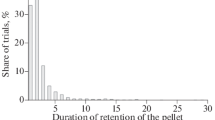Summary
The responses of individual glossopharyngeal neurons of the mud puppy,Necturus maculosus, were examined over an extended concentration series of NaCl, HCl, quinine hydrochloride (QHCl) and sucrose solutions. Neuron isolation was evaluated by a computer program that sorted neural impulses according to amplitude (Fig. 1). When sufficient isolation existed, a second program counted the impulses in each test period as well as in pre- and post-stimulus periods. Response latencies were calculated independently.
The response to taste stimulation took one of three forms: 1) increased activity, 2) decreased activity, or 3) increased activity to the water rinse. For each concentration series the magnitude (SR) and latency functions of the responses were determined. These varied among stimuli and among nerve fibers (Fig. 4). However, the SR and latency functions were found in specific combinations, the most unique being one in which both functions remained constant over an entire concentration series (Fig. 4E, F).
Most neurons responded to more than one of the stimuli. Many, however, responded to at least one of the stimuli with a particular form of response and combination of SR and latency functions (Fig. 6). In this sense they may be considered chemospecific as well as multiply sensitive. Despite the many types of response, the sum of the individual SR functions closely resembled the SR functions of the whole nerve (Fig. 7) and the summed latencies produced a temporal pattern with a phasic component similar to that of the whole nerve response (Fig. 8).
Similar content being viewed by others
Abbreviations
- SR :
-
stimulus concentration vs response magnitude
- L :
-
latency of response
- +,0, -,I (SR orL):
-
magnitude or latency functions with positive, zero, negative or indeterminate slope
- QHCl :
-
quinine hydrochloride
References
Bartoshuk LM, Harned MA, Parks LH (1971) Taste of water in the cat: effects on sucrose preference. Science 171:699–701
Bernard RA (1972) Antidromic inhibition: a new model of taste receptor function. In: Schneider D (ed) Olfaction and taste IV. Wissenschaftliche Verlagsgesellschaft, Stuttgart, pp 301–307
Boudreau JC, Bradley BE, Bierer PR, Kurger S, Tsuchitani C (1971) Single unit recordings from the geniculate ganglion of the facial nerve of the cat. Exp Brain Res 13:461–488
Cohen M, Hagiwara S, Zotterman Y (1955) The response spectrum of taste fibers in the cat: a single fiber analysis. Acta Physiol Scand 33:316–332
Faull JR, Halpern BP (1972) Taste stimuli: time course of peripheral nerve response and theoretical models. Science 178:73–75
Fishman IY (1957) Single fiber gustatory impulses in rat and hamster. J Cell Comp Physiol 49:319–334
Halpern BP (1973) The use of vertebrate laboratory animals in research on taste. In: Gay W (ed) Methods of animal experimentation. Academic Press, New York, pp 302–341
Halpern BP, Tapper D (1971) Taste stimuli: quality coding time. Science 171:1256–1258
Iggo A, Leek BF (1967) The afferent innervation of the tongue of the sheep. In: Hayashi T (ed) Olfaction and taste II. Pergamon, Oxford, pp 493–507
Kusano K (1960) Analysis of the single unit activity of gustatory receptors in the frog tongue. Jpn J Physiol 10:620–633
Mistretta CM (1972) A quantitative analysis of rat chorda tympani fiber discharge patterns. In: Schneider D (ed) Olfaction and taste IV. Wissenschaftliche Verlagsgesellschaft, Stuttgart, pp 294–300
Ogawa H, Sato M, Yamashita S (1969) Gustatory impulse discharge in response to saccharin in rats and hamsters. J Physiol 204:311–329
Ogawa H, Yamashita S, Sato M (1974) Variation in gustatory nerve fiber discharge pattern with change in stimulus concentration and quality. J Neurophysiol 37:443–457
Pfaffmann C (1941) Gustatory afferent impulses. J Cell Comp Physiol 17:243–258
Pfaffmann C (1955) Gustatory nerve impulses in rat, cat and rabbit. J Neurophysiol 18:429–440
Samanen DW (1977) The electrophysiological responses of gustatory neurons of the mud puppy,Necturus maculosus. Doctoral Dissertation. Michigan State University, East Lansing, MI
Sato M, Ogawa H, Yamashita S (1975) Response properties of macaque monkey chorda tympani fibers. J Gen Physiol 66:781–810
Sato T (1976) Latency of taste nerve signals in frog. Experientia 32:877–879
Schneider M, Samanen DW, Bernard RA (1978) A computer method for determining the degree of isolation in single neuron recordings. J Electrophysiol Techn 6:17–26
Taglietti V, Casella C, Ferrari E (1969) Interactions between taste receptors in the frog tongue. Pflügers Arch 312:139–148
West CHK, Bernard RA (1978) Intracellular characteristics and responses of taste bud and lingual cells of the mud puppy. J Gen Physiol 72:305–326
Yinon U, Erickson R (1970) Adaptation and the neural code for taste. Brain Res 23:428–432
Author information
Authors and Affiliations
Additional information
Supported in part by NIH Grant NS09168
The authors wish to thank Mr. Marc Schneider for the computer programs and his expert assistance and Mrs. G. Chapman of Florida State University for photography. We also thank Dr. David V. Smith for his critical comments. This work was submitted in partial fulfillment of the requirements for the Ph. D. degree to Michigan State University by the senior author.
Rights and permissions
About this article
Cite this article
Samanen, D.W., Bernard, R.A. Response properties of the glossopharyngeal taste system of the mud puppy (Necturus maculosus). J. Comp. Physiol. 143, 151–158 (1981). https://doi.org/10.1007/BF00606079
Accepted:
Issue Date:
DOI: https://doi.org/10.1007/BF00606079




